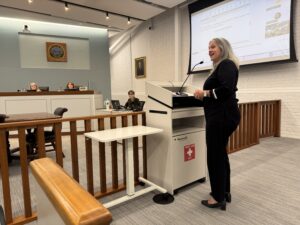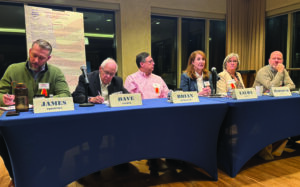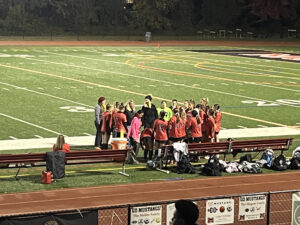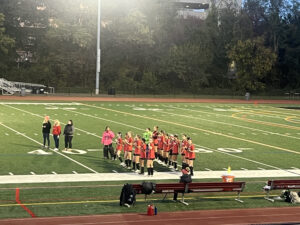
The Fairfax County School Board concluded the two and a half year name change process of J.E.B Stuart High School on Oct. 26 when the board voted 7-4 in favor of renaming Stuart to Justice High School by no later than the start of the 2019-20 school year. The motion looks to get the ball rolling soon by prompting Superintendent Dr. Scott Brabrand to implement a name-change plan by Dec. 14.
Mason district representative Sandy Evans, who authored the motion, suggested the name “Justice” as a catch-all term that would honor the efforts of civil rights activist Barbara Rose Johns, renowned attorney Justice Thurgood Marshall and local war hero Col. Louis G. Mendez, Jr., who received the second, third and fifth most votes, respectively, in a community poll conducted in September. For a small, but dedicated crowd that hung around during the nearly five-hour agenda item, the victory was a sweet resolution.
“I’m very glad the school board made the right choice and they were finally able to come to a real compromise,” Nebal Maysaud, a 2013 Stuart alumnus, said. “People can embody ideas and the [motion] was specific in that this is an idea shared among Louis Mendez, Justice Thurgood Marshall and Barbara Rose Johns.”
Stephen Spitz, an advocate for the name change and the earliest public supporter of renaming the school after Marshall, was also “elated” with the result.Though he won’t let the name alone serve as a victory.
Spitz intends to prod the county about ensuring each figure gets their due in the new school. His early ideas include giving each figure a physical space within the school, incorporating their historical significance into the school’s curriculum and hosting a ceremony where Mendez’s children and Cecilia Suyat, Marshall’s widow, would speak to help commemorate the renaming.
However, the final decision wasn’t handed down without dissent. Original supporters of keeping the name “Stuart,” prior to the board’s July 27 decision to enact the name change, shifted their advocacy around Mendez as the school’s new moniker. To Joe Pisciotta, the board’s decision to go with “Justice” as the new name was a “mockery,” and was another moment where he believed the board ignored their own process. Pisciotta wasn’t alone in his thinking.
“It’s simple. Follow the basics of politics and if a majority of the community wanted that name, you pick that name. They’re over-complicating it,” Haseeb Khan, a junior at Stuart, said. “People voted for ‘Justice Thurgood Marshall High School,’ they didn’t vote for ‘Justice’ only…they’re making that up themselves.”
The split in the audience’s opinion was mirrored in the board’s discussion. One-by-one, the individual motions featuring Johns, Marshall, Mendez and a different iteration of Stuart as the new name were voted down in tight margins, with Mendez being the closest by failing to pass in a 6-6 tie.

Springfield district representative Elizabeth Schultz has been a vocal critic of the board’s procedure throughout. While some of her problems with the board aren’t exclusive to this name change process, such as the lack of transparency in the board’s work and tendency to slow dialogue after a majority is achieved, she feels her colleagues enforced their will over the community in this vote.
“I don’t accept the premise that this was a compromise,” Schultz said, who supported Mendez as the new name. “There was a very clear and distinct process set forward…[but] the advertised process should’ve been ‘We’re going to feign community engagement and, in the end, we’ll decide what’s best.’ If [the board] had said that upfront, there would’ve been a real, true public outcry that we have no intention of honoring or respecting anything we’re telling the public that we’re going to do.”
Evans took issue with the claims that insinuate she and her fellow board members didn’t respect the community’s input throughout the process, particularly in this fall’s name vote or in the May 2016 survey on whether or not the name should’ve been changed at all.
She recalled spending an extensive amount of time reading through the 2016 survey comments and found most objections to the change were cost-related, not arguments for Stuart. Evans also felt the survey’s hit-or-miss response rate clouded the community consensus. For this fall’s vote, the olive branch of keeping “Stuart,” the most-voted for name at the September vote, backfired while the umbrella term “Justice” was a fitting way to represent all the historical figures brought forward by the community.
“By the time we got to the vote on the name, we realized that rather than being a way to unify people [Stuart] was just another way they were divided,” Evans said, who noted that “Justice” was on the ballot and wasn’t a creation of the board. “With that, I felt that by combining the three names you get by far the most votes and honor all three people, so we did listen to the community by coming up with this name.”
Last Thursday’s atmosphere still possessed the distasteful elements of the lengthy process. One attendee jeered brazenly and enthusiastically when a speaker recollected their personal grievances with white supremacy. And when another speaker announced he was reading a letter on behalf of a student who feared for their safety for speaking against the name change, a chorus of chuckles was audible.
One area where the community may be able to rally around is the cost of the name change. Originally projected between $600,000 – $900,000, murmurings that the estimates could be inflated began to permeate following the meeting. Evans and Schultz refused to criticize the work of their staff that compiled the estimates, although Evans did cite a few areas where the estimate may be eligible for trimming. That included painting over the “J.E.B” on the football field instead of installing new turf and potentially acquiring band uniform replacements through cheaper avenues.
As the board and Brabrand scrub the numbers prior to Dec. 14, there’s a chance a hard cost estimate may be significantly lower than expected. If Evans’ inklings are right – that most people were opposed to the change due to financial reasons – news of a reduced cost could help pacify any residual concerns.
But that’s down the line. In the short-term, the community looks to rekindle some feelings of normalcy after a bitter and, at times, confounding process. For the sake of their neighbors, and most importantly, the students themselves, it’s the only way forward following this exhausting saga.












